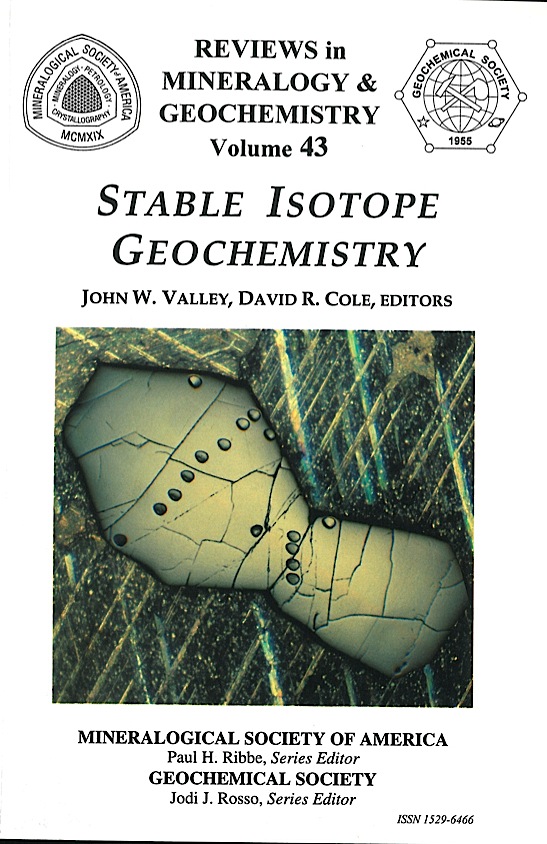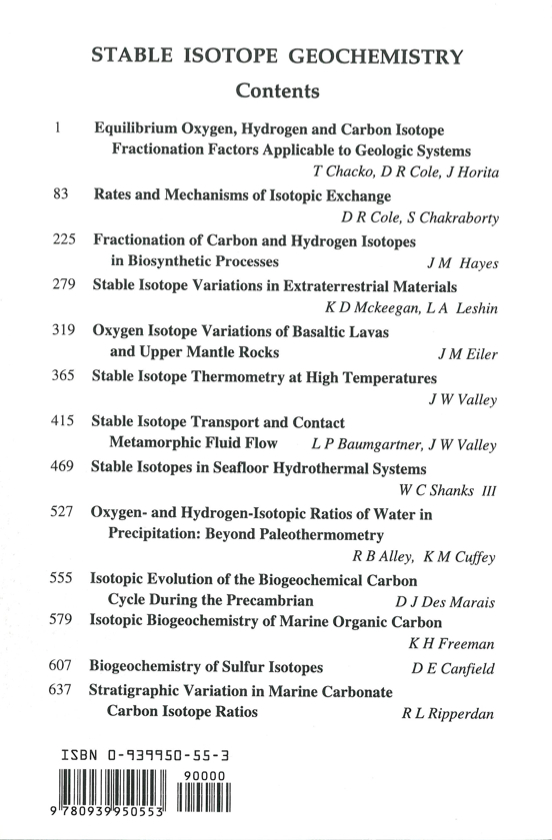

Mineralogical Society of America, Founded December 30, 1919
Order Publications Online (25% discount for MSA, CMS and GS members, except shipping)
MinPubs.org Pay-Per-View GeoScienceWorld Pay-Per-View


2001 i-x11 + 531 pages. ISBN 0-939950-55-3; ISBN13 978-0-939950-55-3
This volume was prepared for Short Course on Stable Isotope Geochemistry presented November 2-4, 2001 in conjunction with the annual meetings of the Geological Society of America in Boston, Massachusetts.
This volume follows the 1986 Reviews in Mineralogy (Vol. 16) in approach but reflects significant changes in the field of Stable Isotope Geochemistry. In terms of new technology, new sub-disciplines, and numbers of researchers, the field has changed more in the past decade than in any other since that of its birth. Unlike the 1986 volume, which was restricted to high temperature fields, this book covers a wider range of disciplines. However, it would not be possible to fit a comprehensive review into a single volume. Our goal is to provide state-ofthe-art reviews in chosen subjects that have emerged or advanced greatly since 1986.
The field of Stable Isotope Geochemistry was born of a good idea and nurtured by technology. In 1947, Harold Urey published his calculated values of reduced partition function for oxygen isotopes and his idea (a good one!) that the fractionation of oxygen isotopes between calcite and water might provide a means to estimate the temperatures of geologic events. Building on wartime advances in electronics, Alfred Nier then designed and built the dual-inlet, gassource mass-spectrometer capable of making measurements of sufficient precision and accuracy. This basic instrument and the associated extraction techniques, mostly from the 1950s, are still in use in many labs today. These techniques have become "conventional" in the sense of traditional, and they provide the benchmark against which the accuracy of other techniques is compared.
The 1986 volume was based almost exclusively on natural data obtained solely from conventional techniques. Since then, revolutionary changes in sample size, accuracy, and cost have resulted from advances in continuous flow massspectrometry, laser heating, ion microprobes, and computer automation. The impact of new technology has differed by discipline. Some areas have benefited from vastly enlarged data sets, while others have capitalized on in situ analysis and/or micro- to nanogram size samples, and others have developed because formerly intractable samples can now be analyzed. Just as Stable Isotope Geochemistry is being reborn by new good ideas, it is still being nurtured by new technology.
The organization of the chapters in this book follows the didactic approach of the 2001 short course in Boston. The first three chapters present the principles and data base for equilibrium isotope fractionation and for kinetic processes of exchange. Both inorganic and biological aspects are considered. The next chapter reviews isotope compositions throughout the solar system including massindependent fractionations that are increasingly being recognized on Earth. The fifth chapter covers the primitive compositions of the mantle and subtle variations found in basalts. This is followed by three chapters on metamorphism, isotope thermometry, fluid flow, and hydrothermal alteration. The next chapter considers water cycling in the atmosphere and the ice record. And finally, there are four chapters on the carbon cycle, the sulfur cycle, organic isotope geochemistry and extinctions in the geochemical record.
John W. Valley, Madison, Wisconsin, USA
David R. Cole, Oak Ridge, Tennessee, USA
August 15, 2001
Title Page
p. i
Copyright
p. ii
Dedication
p. iii
Foreword & Preface
p. iv - vi
Table of Contents
p. vii - xiv
Chapter 1. Equilibrium Oxygen, Hydrogen and Carbon Isotope Fractionation Factors Applicable to Geologic Systems
by Thomas Chacko, David R. Cole, and Juske Horita, p. 1 - 82
Chapter 2. Rates and Mechanisms of Isotopic Exchange
by David R. Cole and S Chakraborty, p. 83 - 224
Errata for Chapter 2 pdf or html
Chapter 3. Fractionation of Carbon and Hydrogen Isotopes in Biosynthetic Processes
by John M Hayes, p. 225 - 278
Chapter 4. Stable Isotope Variations in Extraterrestrial Materials
by Kevin D. Mckeegan and Laurie A Leshinv, p. 279 - 318
Chapter 5. Oxygen Isotope Variations of Basaltic Lavas and Upper Mantle Rocks
by John M. Eiler, p. 319 - 364
Chapter 6. Stable Isotope Thermometry at High Temperatures
by John W. Valley, p. 365 - 414
Chapter 7. Stable Isotope Transport and Contact Metamorphic Fluid Flow
by Lukas P. Baumgartner and John W. Valley, p. 415 - 468
Chapter 8. Stable Isotopes in Seafloor Hydrothermal Systems
by Wayne C. Shanks III, p. 469 - 526
Chapter 9. Oxygen- and Hydrogen-Isotopic Ratios of Water in Precipitation: Beyond Paleothermometry
by Richard B. Alley and Kurt M. Cuffey, p. 527 - 554
Chapter 10. Isotopic Evolution of the Biogeochemical Carbon Cycle During the Precambrian
by David J. Des Marais, p. 555 - 578
Chapter 11. Isotopic Biogeochemistry of Marine Organic Carbon
by Katherine H. Freeman, p. 579 - 606
Chapter 12. Biogeochemistry of Sulfur Isotopes
by Don E. Canfield, p. 607 - 636
Chapter 13. Stratigraphic Variation in Marine Carbonate Carbon Isotope Ratios
by Robert L. Ripperdan, p. 637 - 662